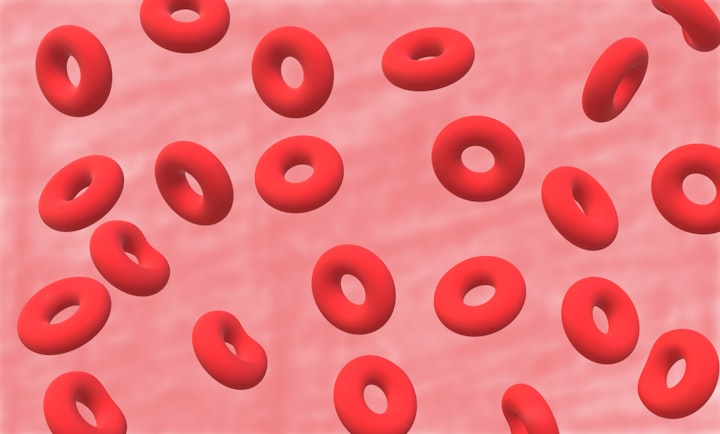Why is human blood red
because of the hemoglobin inside our red blood cells

Human blood is red due to the presence of hemoglobin, a protein molecule found in red blood cells. Hemoglobin plays a crucial role in the transport of oxygen from the lungs to the tissues and carbon dioxide from the tissues back to the lungs. This process is essential for sustaining life and maintaining the body's functions.
The color of human blood is a result of the interaction between hemoglobin and oxygen. When oxygen binds to hemoglobin, it forms oxyhemoglobin, which gives blood its bright red color. Deoxygenated blood, which has released its oxygen to the tissues, appears darker red or even blue when seen through the skin.
Hemoglobin is composed of four protein subunits, each containing a heme group with an iron atom at its center. The iron atom is responsible for binding to oxygen molecules and facilitating their transport throughout the body. The heme groups also contribute to the red color of blood by absorbing and reflecting light in the visible spectrum.
The process of oxygen transport begins in the lungs, where oxygen diffuses into the bloodstream and binds to hemoglobin in red blood cells. As blood circulates through the body, oxygen is released from hemoglobin and taken up by tissues for cellular respiration. Carbon dioxide, a waste product of metabolism, is then carried back to the lungs by hemoglobin for exhalation.
In addition to its role in gas exchange, hemoglobin also helps regulate pH balance in the blood by buffering acids and bases. This function is essential for maintaining homeostasis and ensuring that bodily functions operate within a narrow range of optimal conditions.
The structure and function of hemoglobin are finely tuned to meet the body's metabolic demands and respond to changes in oxygen levels. Variations in hemoglobin concentration, oxygen affinity, and other factors can impact overall health and contribute to conditions such as anemia, hypoxia, and respiratory disorders.
Anemia is a common condition characterized by low levels of hemoglobin or red blood cells, leading to symptoms such as fatigue, weakness, and shortness of breath. Iron deficiency anemia is one of the most prevalent forms of anemia worldwide and can be caused by inadequate dietary intake, chronic blood loss, or other factors affecting iron absorption or utilization.
Hypoxia occurs when tissues do not receive enough oxygen due to reduced oxygen-carrying capacity or impaired circulation. Chronic hypoxia can have serious consequences for organ function and may result from conditions such as heart failure, lung disease, or high-altitude exposure.
piratory disorders, such as asthma, chronic obstructive pulmonary disease (COPD), and pulmonary fibrosis, can affect the ability of the lungs to exchange oxygen and carbon dioxide efficiently. These conditions may lead to decreased oxygen saturation in the blood, increased carbon dioxide levels, and impaired respiratory function.
Inherited disorders of hemoglobin, such as sickle cell disease and thalassemia, can also impact the structure and function of red blood cells. Sickle cell disease is caused by a mutation in the gene encoding hemoglobin, leading to the production of abnormal hemoglobin molecules that cause red blood cells to become rigid and sickle-shaped. These abnormal cells can block blood flow, causing pain, organ damage, and other complications.
Thalassemia is a group of genetic disorders characterized by reduced production of hemoglobin subunits, resulting in anemia and other symptoms. Individuals with thalassemia may require regular blood transfusions or other treatments to manage their condition and prevent complications.
Blood disorders affecting platelets or clotting factors can also impact the color and composition of blood. Platelets are essential for forming blood clots to stop bleeding after injury, while clotting factors help regulate the coagulation process. Disorders such as hemophilia, von Willebrand disease, and thrombocytopenia can disrupt normal clotting mechanisms and increase the risk of bleeding or abnormal bruising.
The color of human blood can vary depending on its oxygenation status, pH level, and other factors. In addition to red blood cells, blood contains white blood cells (leukocytes) that play a critical role in the immune response by defending against infections and foreign invaders. White blood cells are produced in the bone marrow and circulate in the bloodstream to detect and eliminate pathogens through various mechanisms.
The immune system is a complex network of cells, tissues, and organs that work together to protect the body from harmful substances and pathogens. In addition to white blood cells, the immune system includes lymphoid organs such as the thymus, spleen, lymph nodes, and tonsils that help coordinate immune responses.
The innate immune system provides rapid but nonspecific defense against a wide range of pathogens through physical barriers (e.g., skin), phagocytic cells (e.g., macrophages), natural killer cells, and inflammatory responses. The adaptive immune system offers more specific protection by generating antibodies and memory T-cells that target specific antigens encountered during infection or vaccination.






Comments (1)
nice story